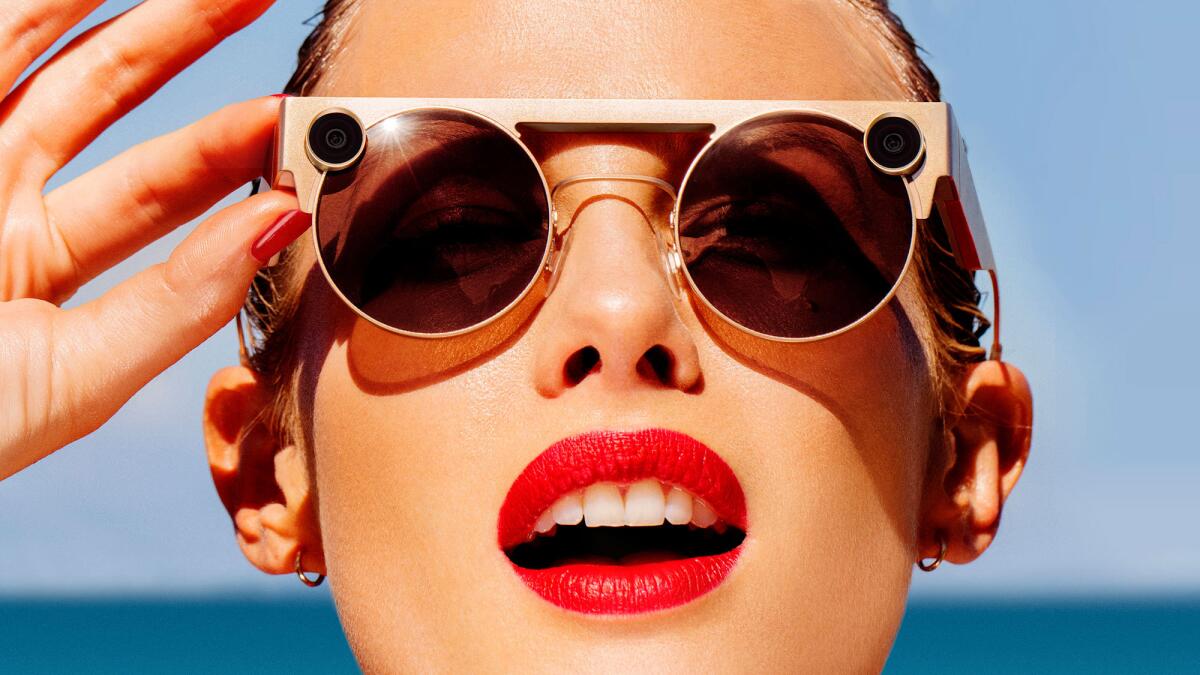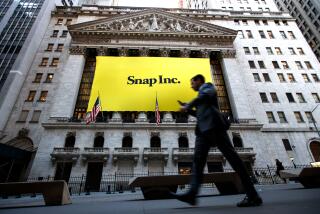Spectacles were a flop. So Snap is going to charge more this time around

- Share via
Snap Inc.’s newest camera glasses are making headlines for their $380 price tag and chic design.
But what’s most remarkable, from a business standpoint, is how little money the company expects to make off its splashy new wearable.
Spectacles 3 got a sleek photo feature in Vogue for their debut, and their specs match the upmarket venue: steel frames, two cameras (allowing for 3-D recording), and that high sticker price, twice what the earlier plastic version, first launched in 2016, cost.
But charging more for them doesn’t indicate Snap is bullish about finding a ready market. If anything, it’s the reverse. Having failed to stoke demand for two previous iterations of the product, the company is treating this one as a niche offering and setting expectations accordingly.
The Spectacles 3 are available for preorder now, and set to ship in the fall, but the company says they will only be a “limited edition,” with production just a fraction of the original version.
Michael Pachter, an analyst at Wedbush, called Snap’s hardware play a “sideshow,” adding that any profit it throws off is likely to be little more than a rounding error.
Just breaking even on Spectacles would be an improvement. People bought more than 200,000 pairs of the first version after their 2016 debut, but Snap still ended up with $40 million in unsold inventory by late 2017, when it wrote off the warehouses of unworn sunglasses as a loss. In the company’s most recent earnings report in July, it noted that revenue from the second generation was “not material.”
In the appeal to luxury consumers and the performative secrecy around development -- Snap granted Vogue interviews with the designers behind the Spectacles 3, but didn’t allow the reporter to identify them by name -- Snap appears to be emulating Apple. Snap CEO Evan Spiegel reportedly keeps a portrait of Apple co-founder Steve Jobs hanging in his office.
But the Apple product closest to the Spectacles isn’t the world-dominating iPhone as much as the Apple Watch, a wearable device that largely disappointed expectations in its first few years. An ultra-high-end edition of the timepiece costing between $10,000 and $17,000 fared particularly poorly, selling in the low tens of thousands of units.
Another unavoidable parallel: Google Glass. When the search giant launched its futuristic augmented-reality headgear in 2013, it required hopeful Glassers to write an essay to apply to join the beta testing class of Glass Explorers, and pay $1,500 once selected. With its geeky looks and intrusive camera, Glass inspired countless jokes and even some bans rather than gotta-have-it fandom. That Google never officially launched it as a product didn’t make much difference in the consensus judgment of it as a corporate face-plant.
Snap’s continued investment into face cameras may be less of a business strategy and more of a signal, or a symbol, of the company’s ambitions — and the limited release may serve as a signal to investors that the company isn’t sinking too much cash into what amounts to a pet project.
“These guys consider themselves a camera company,” Pachter said, explaining the logic behind pursuing an unprofitable hardware play. “So they probably should sell cameras.”
The Spectacles still require a phone to work: Users can sync the videos recorded from the sunglasses with their smartphones via Bluetooth or wifi, and then share them on Snapchat, the company’s social-messaging app. But getting the camera out of users’ hands and onto their faces has long been part of Spiegel’s vision for the company.
Snapchat’s augmented reality camera filters — like the popular recent gender-swap filter — already drive increased usage of the app, according to the company, but a Snap spokesman said the latest Spectacles are meant “to draw our community closer to a future in which computing is overlaid on the world, rather than confined to a small screen.”
While Snap is developing the software that could power that kind of future within Snapchat, its Spectacles are circumscribed in scope compared to some of the augmented reality devices being developed by deep-pocketed tech giants such as Facebook, Microsoft and Apple, as well as AR-focused companies such as Magic Leap. Those glasses can already project digital images into a user’s field of vision. Spectacles can record only what’s in front of the user’s face.
One thing they’re unlikely to capture for the foreseeable future: other people wearing Spectacles.







